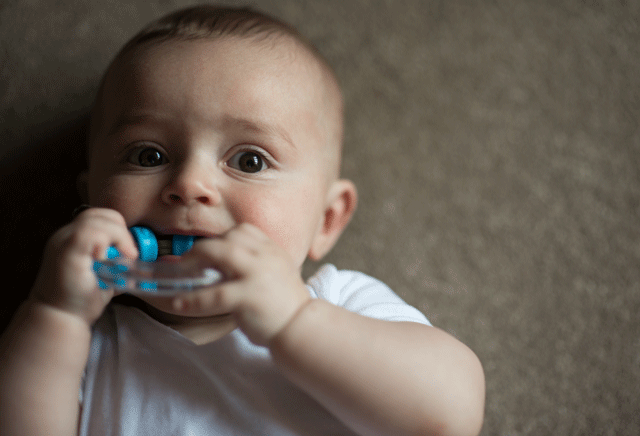Parents rely on teething rings and soothers to ease their baby’s aching gums, but new research is warning that these products may be leaching low levels of harmful chemicals, even if they’re labelled as BPA-free or non-toxic.

A new study published Wednesday is warning that babies could be at risk of exposure to a handful of chemicals from these teething products. The findings were published in the journal Environmental Science & Technology.
So far, BPA has been banned in the production of baby bottles. Exposure to the chemical is a concern because of the possible health effects on the brain, behaviour and prostate glands of fetuses, infants and kids, the Mayo Clinic says.
READ MORE: Shopping receipts might increase exposure to BPA chemical
In 2011, the European Commission banned the use of BPA in baby bottles. A year later the U.S. banned it from kids’ cups on a whole. Health Canada did the same in its Canada Consumer Product Safety Act in 2010, too.
Since then manufacturers say they’ve stepped away from using BPA and other compounds in all products, like Tupperware or other plastic goods, but the researchers said there was a gap in research on teethers and their makeup.
In the study, American Chemical Society scientists zeroed in on 59 solid, gel or water-filled teethers they purchased online. They tested the products for 29 different compounds. They didn’t reveal the list of products they focused on.
Turns out, they all contained BPA, even if they were marketed as BPA-free or non-toxic. Compounds even leached out of the products and into water.
READ MORE: ‘Educational’ products don’t make babies smarter, Canadian study suggests
- 3 women diagnosed with HIV after ‘vampire facials’ at unlicensed U.S. spa
- Solar eclipse eye damage: More than 160 cases reported in Ontario, Quebec
- ‘Super lice’ are becoming more resistant to chemical shampoos. What to use instead
- Canadian man dies during Texas Ironman event. His widow wants answers as to why
But there is one caveat, though. The researchers concede that the amount of exposure to these chemicals is “lower than European standards for temporary tolerable daily intake.”
Their concern is that these thresholds are based on individual compounds and doesn’t consider the combined effect, if any.
While parents may be worried, critics suggest the findings are overblown. Keep in mind, the products were tested by federal health departments, the American Juvenile Products Manufacturers Association said, calling the findings “misleading.”
READ MORE: Sleep machines may be harmful to babies’ hearing, speech: study
The American Chemistry Council is skeptical of the findings, too. It said the study “provides very little useful information for the parents of young children as it focuses on the mere presence of chemicals, which parents should be reassured does not equate to harm,” it said in a statement.
Health Canada said it had no comment because it “has not been given an opportunity to review this particular study, or any associated materials/publications.”
“Health Canada will review the report once it is available. At any time, if new information becomes available that identifies a potential risk to the health and safety of Canadians, Health Canada will take action to review the information and to mitigate the risk as appropriate,” a spokesman said in an email to Global News.






Comments